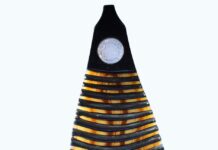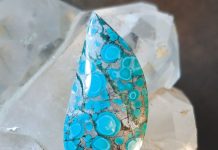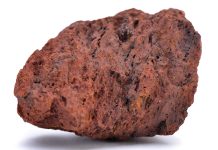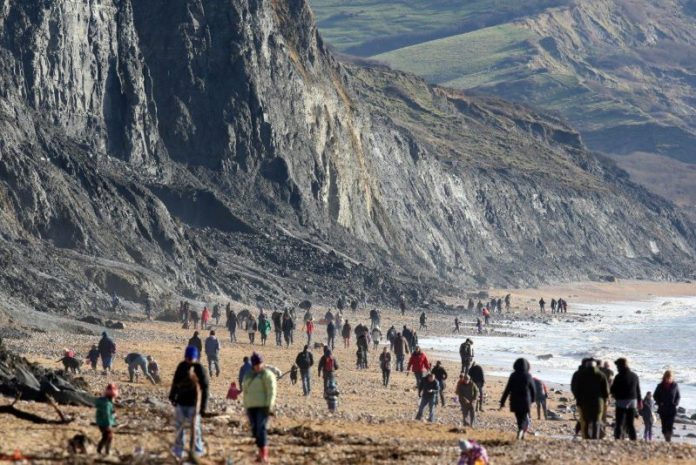
England’s Jurassic Coast stands out among the world’s fossil beaches whether measured by size, history, fossil abundance, collector interest, international recognition or paleontological significance.
Much more than just a fossil beach, the Jurassic Coast is a readily accessible World Heritage Site of stunning natural beauty where collectors can search for fossils, visit fossil museums, walk in the footsteps of a legendary fossil collector, and attend an internationally acclaimed fossil festival.
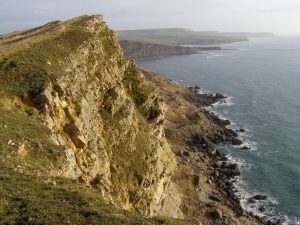
Wikimedia Commons
England’s Fossil Beach
The Jurassic Coast is a 96-mile-long stretch of steep cliffs, imposing headlands and narrow beaches in southern England. Fronting the English Channel, it extends from Swanage in Dorset west to Exmouth in East Devon. Composed of fossiliferous Triassic, Jurassic and Cretaceous sediments, its cliffs represent 185 million years of geological time that covers the entire Mesozoic Era.
One of the few localities on Earth where Triassic, Jurassic, and Cretaceous rocks are exposed in one place, the Jurassic Coast is named for its particular abundance of Jurassic Period fossils. The coast’s soft cliffs crumble readily, especially in winter rains and winds, releasing countless millions of fossils onto the lower beaches. Although these newly exposed fossils survive only briefly before being claimed by storm waves, they are continually replenished.
History
Midway along the Jurassic Coast near the community of Lyme Regis, the cliffs consist of fossil-rich limestone and shale layers of the Blue Lias Formation. They originated as sea bottom sediments laid down 200 million years ago during the late Triassic and early Jurassic periods.
Although known in ancient times, these fossils received little attention until the late 1700s when Lyme Regis became popular as a seaside resort for the English gentry and middle class. Locals began collecting the fossils and were soon selling them as curios to a growing number of visitors.
At that time, the true nature and age of the fossils, and their place and significance in geological history, were not understood. The Lyme Regis fossils were valued primarily for their uniqueness and visual appeal, and also for their purported medicinal uses or mystical powers. Ammonites were sold as “snake stones,” belemnites as “devil’s fingers,” and reptile and fish vertebrae as “verteberries.”

Lyme Regis Fossil Festival
Mary Anning
In the early 1800s, paleontology was just beginning to emerge as a science. And one individual who played a profound role in its development was Mary Anning, who was born in Lyme Regis in 1799. As a child, she began collecting and selling fossils to tourists to supplement her family’s meager income. At age 12, Anning discovered a nearly complete skeleton and four-foot-long skull of an ichthyosaur, a large, extinct marine reptile. A decade later she recovered the first intact skeleton of a plesiosaur, a similar reptile. The latter find established her as a serious amateur paleontologist despite her limited education.
By then, leading English geologists and paleontologists visited Lyme Regis regularly to buy Anning’s fossils. She had also taught herself geological, anatomical and paleontological illustration, and began rendering technically accurate sketches of her recoveries. Anning’s specimens and sketches greatly aided scientists as they advanced the emerging theories of evolution and extinction and began to grasp the immense scale of geological time.
Anning died in 1847, having received little credit for her contributions to paleontology. Full recognition finally came in 2010 when the preeminent Royal Society of London listed her among the ten most influential women scientists in British history.
Fossil Collecting Today
The survivability “window” of Jurassic Coast fossils is brief; specimens exposed one day can literally be claimed by the sea the next. This means that only public involvement can maximize the number of fossils that are saved for scientific research and museum display.
In 1998, a consortium of landowners, scientists, government agencies, cultural and environmental organizations and fossil collectors hammered out a Collecting Code of Conduct for the Lyme Regis area. This Code encourages public fossil collecting while clarifying fossil ownership and enabling collectors to keep most specimens while ensuring that scientifically valuable specimens are reported and preserved. It also emphasizes collecting safety, as the unstable cliffs can be dangerous. As a model of cooperation between diverse interests, the Code has worked well at Lyme Regis and is being adopted in other coastal sections.

Lyme Regis Fossil Festival
The Lyme Regis Fossil Festival
In 2001, the Jurassic Coast received international attention when it was recognized as a UNESCO World Heritage Site for its extraordinary paleontological and historical significance. The following year saw the inauguration of the Lyme Regis Fossil Festival. Celebrating the geological heritage of the Jurassic Coast as England’s largest public paleontological event, this two-day festival attracts thousands of visitors who enjoy talks by paleontologists, historians and expert collectors, along with guided fossil-collecting walks, superb fossil exhibits, fossil-preservation workshops, stage shows and entertainment.
Especially popular are the historical impersonations of Mary Anning staged before the recently unveiled, life-sized bronze sculpture of the now-famous fossil collector and amateur paleontologist. Festival visitors can also attend showings of the 2021 movie Ammonite, a romantic drama with actress Kate Winslet playing the part of Mary Anning. Considering today’s booming interest in Jurassic Coast fossils, the real Mary Anning would certainly be proud.
For further information, visit www.fossilfestival.com.
This story about England’s Jurassic Coast previously appeared in Rock & Gem magazine. Click here to subscribe. Story by Steve Voynick.



